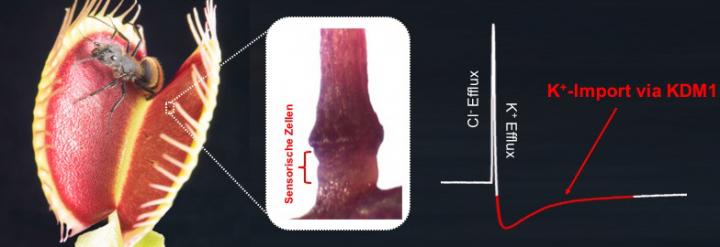
Credit: (Picture: Ines Kreuzer, Soenke Scherzer / University of Wuerzburg)
All plant cells can be made to react by touch or injury. The carnivorous Venus flytrap (Dionaea muscipula) has highly sensitive organs for this purpose: sensory hairs that register even the weakest mechanical stimuli, amplify them and convert them into electrical signals that then spread quickly through the plant tissue.
Researchers from Julius-Maximilians-Universität (JMU) Würzburg in Bavaria, Germany, have isolated individual sensory hairs and analysed the gene pool that is active in catching insects. “In the process, we found for the first time the genes that presumably serve throughout the plant kingdom to convert local mechanical stimuli into systemic signals,” says JMU plant researcher Professor Rainer Hedrich.
That’s a fine thing, because virtually nothing was known about mechano-receptors in plants until now. Hedrich’s team presents the results in the open-access journal PLOS Biology.
Sensory hairs convert touch into electricity
The hinged trap of Dionaea consists of two halves, each carrying three sensory hairs. When a hair is bent by touch, an electrical signal, an action potential, is generated at its base. At the base of the hair are cells in which ion channels burst open due to a stretching of their envelope membrane and become electrically conductive. The upper part of the sensory hair acts as a lever that amplifies the stimulus triggered by even the lightest prey.
These micro-force-touch sensors thus transform the mechanical stimulus into an electrical signal that spreads from the hair over the entire flap trap. After two action potentials, the trap snaps shut. Based on the number of action potentials triggered by the prey animal during its attempts to free itself, the carnivorous plant estimates whether the prey is big enough – whether it is worth setting the elaborate digestion in motion.
From genes to the function of the touch sensor
To investigate the molecular basis for this unique function, Hedrich’s team “harvested” about 1000 sensory hairs. Together with JMU bioinformatician Professor Jörg Schultz, they set out to identify the genes in the hairs.
“In the process, we noticed that the fingerprint of the genes active in the hair differs from that of the other cell types in the trap,” says Schulz. How is the mechanical stimulus converted into electricity? “To answer this, we focused on the ion channels that are expressed in the sensory hair or are found exclusively there,” says Hedrich.
In search of further ion channels
The sensory hair-specific potassium channel KDM1 stood out. Newly developed electrophysiological methods showed that without this channel, the electrical excitability of the sensory hairs is lost, i.e. they can no longer fire action potentials. “Now we need to identify and characterise the ion channels that play an important role in the early phases of the action potential,” Hedrich said.
###
Media Contact
Prof. Dr. Rainer Hedrich
[email protected]
Original Source
https:/
Related Journal Article
http://dx.




